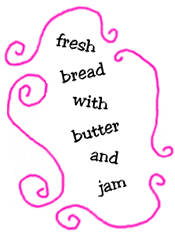 Q Dear Miss Abigail:
Q Dear Miss Abigail:
What can you tell me about the proper way to serve tea? If this is too general, would you kindly address afternoon tea service in the home? Still too general? Perhaps you might look at the question of accompanying food service (e.g., pickled jellyfish, toast points, hot buttered brioche &c.).
With my keen appreciation,
Allow me to attest myself most sincerely,
Signed,
Chauncy Rutherford Phipps Delaney Smutte
A Dear Sir Smutte:
Here are a few bits of advice about afternoon tea ~ hosting, attending, and what food should be served. That should cover the basics for you, and help in your quest for proper tea etiquette. So settle in ~ pull up a comfortable chair, grab a biscuit, and chat with the other guests while I pour you a lovely cup of tea.
1938: Tea for Callers
![]() When you have only a few guests, it is pleasant to serve tea in the living room, or library, or on the porch when the weather is favorable. Or perhaps your own room is a cozy and suitable place for entertaining. Is it fixed up as a sitting room, with a studio bed, gay-colored sofa cushions, comfortable chairs and window seats? If so, add a cupboard in which to keep cups and saucers and a teapot. Lay in a package or so of tea biscuits or cookies, a tin of tea balls, and a box of loaf sugar. And there you are ~ all ready to produce impromptu refreshments whenever friends drop in to see you!
When you have only a few guests, it is pleasant to serve tea in the living room, or library, or on the porch when the weather is favorable. Or perhaps your own room is a cozy and suitable place for entertaining. Is it fixed up as a sitting room, with a studio bed, gay-colored sofa cushions, comfortable chairs and window seats? If so, add a cupboard in which to keep cups and saucers and a teapot. Lay in a package or so of tea biscuits or cookies, a tin of tea balls, and a box of loaf sugar. And there you are ~ all ready to produce impromptu refreshments whenever friends drop in to see you!
Another way in which to gain experience that will help you when you come to give a really big tea party is to serve tea to your mother’s friends when they come to call on her. She, and they, will appreciate your thoughtfulness and courtesy; and you will soon become expert in the serving of tea and in the arranging of tea tables and trays.![]()
Source: Pierce, Beatrice. The Young Hostess. New York: Farrar & Rinehart, 1938.
~ p. 65 ~
1963: Attendance at a Tea
![]() The one thing to do before attending a tea is to eat in order that you will have very little appetite to do that same when you arrive at what is truly a feminine setting. Approaching the tea-table, we greet the person who is “pouring”; exchange a few pleasantries; tell her if you prefer cream or lemon in your tea. Then, regardless of how much we would like to try each variety of sandwiches or cookies, we do not laden the plate with more than a total of three or four of the delicacies.
The one thing to do before attending a tea is to eat in order that you will have very little appetite to do that same when you arrive at what is truly a feminine setting. Approaching the tea-table, we greet the person who is “pouring”; exchange a few pleasantries; tell her if you prefer cream or lemon in your tea. Then, regardless of how much we would like to try each variety of sandwiches or cookies, we do not laden the plate with more than a total of three or four of the delicacies.![]()
Source: Culkin, Anne. Charm for Young Women. New York: Deus Books, 1963.
~ p. 85 ~
1967: The Food
![]() Tea refreshments are quite different from those served at a cocktail party, and it is not wise to try to combine the two. People who love tea begin with some simple, bland thing like thin, very fresh bread with butter and jam. (For this plain bread and butter the crusts are left on, for sandwiches they are removed.) They may pass on to more complex combinations, such as watercress sandwiches, chopped candied ginger and cream cheese sandwiches, little hot, toasted cheese rolled sandwiches, open-faced rounds or crab or lobster mixture on soft white or graham bread ~ the tea kind of food, not the cocktail appetizers.
Tea refreshments are quite different from those served at a cocktail party, and it is not wise to try to combine the two. People who love tea begin with some simple, bland thing like thin, very fresh bread with butter and jam. (For this plain bread and butter the crusts are left on, for sandwiches they are removed.) They may pass on to more complex combinations, such as watercress sandwiches, chopped candied ginger and cream cheese sandwiches, little hot, toasted cheese rolled sandwiches, open-faced rounds or crab or lobster mixture on soft white or graham bread ~ the tea kind of food, not the cocktail appetizers.![]()
Source: Vanderbilt, Amy. New Complete Book of Etiquette: Guide to Gracious Living. Garden City, N.J.: Doubleday & Company, Inc., 1967.
~ p. 289 ~